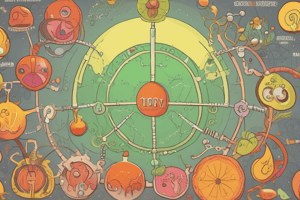Podcast
Questions and Answers
Where does the process of glycolysis occur?
Where does the process of glycolysis occur?
- Cytoplasm (correct)
- Endoplasmic reticulum
- Mitochondria
- Nucleus
What happens to the carbon atoms during glycolysis?
What happens to the carbon atoms during glycolysis?
- They are converted into ATP
- They are stored in the mitochondria
- They are split into two molecules of pyruvate (correct)
- They are released as carbon dioxide
What is the energy yield of glycolysis?
What is the energy yield of glycolysis?
- 36 ATP
- 4 ATP
- 0 ATP
- 2 ATP (correct)
What is the purpose of the energy-investment phase of glycolysis?
What is the purpose of the energy-investment phase of glycolysis?
How is glycolysis regulated?
How is glycolysis regulated?
What is the result of high levels of ATP binding to the regulatory site of phosphofructokinase?
What is the result of high levels of ATP binding to the regulatory site of phosphofructokinase?
What is the condition required for re-oxidation of FADH2?
What is the condition required for re-oxidation of FADH2?
What is the significance of the fourth step of glycolysis?
What is the significance of the fourth step of glycolysis?
Which stage of cellular respiration can function anaerobically?
Which stage of cellular respiration can function anaerobically?
What is the role of CoA in the citric acid cycle?
What is the role of CoA in the citric acid cycle?
Why is it necessary for ATP to bind to the active site of phosphofructokinase?
Why is it necessary for ATP to bind to the active site of phosphofructokinase?
What is the net production of ATP per glucose molecule in the reactions so far?
What is the net production of ATP per glucose molecule in the reactions so far?
Where is most of the energy stored at this point?
Where is most of the energy stored at this point?
Where is the electron transport chain located in the mitochondrion?
Where is the electron transport chain located in the mitochondrion?
What happens to the electrons as they pass through the electron transport chain?
What happens to the electrons as they pass through the electron transport chain?
What is the result of electron transfer in the electron transport chain?
What is the result of electron transfer in the electron transport chain?
What is the net ATP yield of glycolysis?
What is the net ATP yield of glycolysis?
What is required to keep glycolysis running?
What is required to keep glycolysis running?
In anaerobic respiration, what is the terminal electron acceptor?
In anaerobic respiration, what is the terminal electron acceptor?
What is the primary mechanism of ATP production in fermentation?
What is the primary mechanism of ATP production in fermentation?
What is the flow of energy during cellular respiration?
What is the flow of energy during cellular respiration?
What is the purpose of the proton-motive force in the electron transport chain?
What is the purpose of the proton-motive force in the electron transport chain?
What is the role of ATP synthase in the electron transport chain?
What is the role of ATP synthase in the electron transport chain?
What is the process by which energy from a proton-motive force is used to drive ATP synthesis?
What is the process by which energy from a proton-motive force is used to drive ATP synthesis?
Flashcards are hidden until you start studying
Study Notes
Cellular Respiration
- In the absence of oxygen, NADH can be re-oxidized, but FADH2 can only be re-oxidized when oxygen is available.
- Glycolysis is the only stage of cellular respiration that can function anaerobically.
- CoA is used in two steps of the citric acid cycle, acting as an agent to drive the reactions forward.
Oxidative Phosphorylation: Electron Transport Chain and Chemiosmosis
- Electrons are transferred from NADH or FADH2 to the electron transport chain.
- The electron transport chain is located in the inner mitochondrial membrane.
- Electrons are passed through a series of proteins to oxygen, ultimately forming H2O.
- The electron transport chain generates no ATP, but breaks the large free-energy drop from food to O2 into smaller steps.
- Electron transfer in the electron transport chain causes proteins to pump H+ ions from the mitochondrial matrix to the intermembrane space, creating a proton-motive force.
- The energy stored in the H+ gradient is used to drive ATP synthesis through chemiosmosis.
- ATP synthase uses the exergonic flow of H+ ions to drive ATP synthesis.
Chemiosmosis
- Chemiosmosis is the use of energy in a H+ gradient to drive cellular work.
- In oxidative phosphorylation, the energy from the electron transport chain is used to pump H+ ions across the membrane, creating a proton-motive force.
- This force is then used to drive ATP synthesis through ATP synthase.
Fermentation and Anaerobic Respiration
- Glycolysis can produce ATP with or without oxygen, but most cellular respiration requires oxygen to produce ATP.
- In the absence of oxygen, glycolysis couples with fermentation or anaerobic respiration to produce ATP.
- Anaerobic respiration uses an electron transport chain with an acceptor other than O2, such as sulfate.
- Fermentation uses substrate-level phosphorylation to generate ATP.
Citric Acid Cycle and Oxidative Phosphorylation
- The citric acid cycle completes the breakdown of glucose.
- Oxidative phosphorylation accounts for most of the ATP synthesis.
Glycolysis
- Glycolysis breaks down glucose into two molecules of pyruvate.
- Glycolysis occurs in the cytoplasm and has three major phases: energy-investment, cleavage, and energy-payoff.
- Two ATP are used at the beginning of glycolysis to phosphorylate the glucose.
- Glycolysis is regulated by feedback inhibition.
- High levels of ATP inhibit the third enzyme, phosphofructokinase.
- Phosphofructokinase has two binding sites for ATP: one active site and one regulatory site.
- The fourth step of glycolysis is the aldolase step, where the molecule is broken into two pieces.
Studying That Suits You
Use AI to generate personalized quizzes and flashcards to suit your learning preferences.




